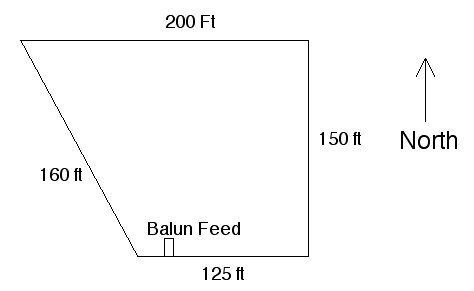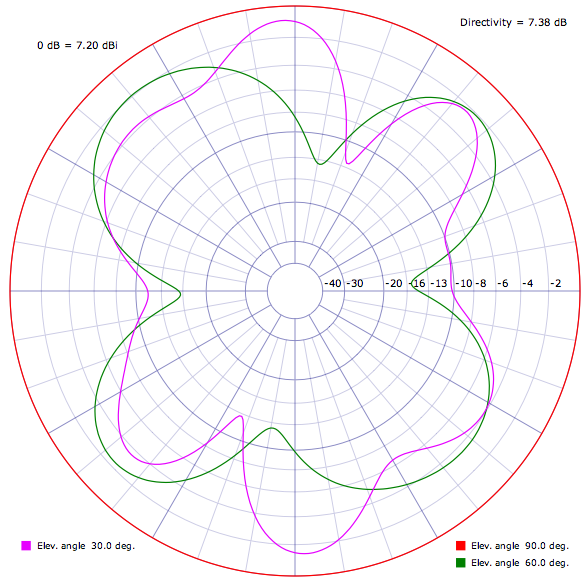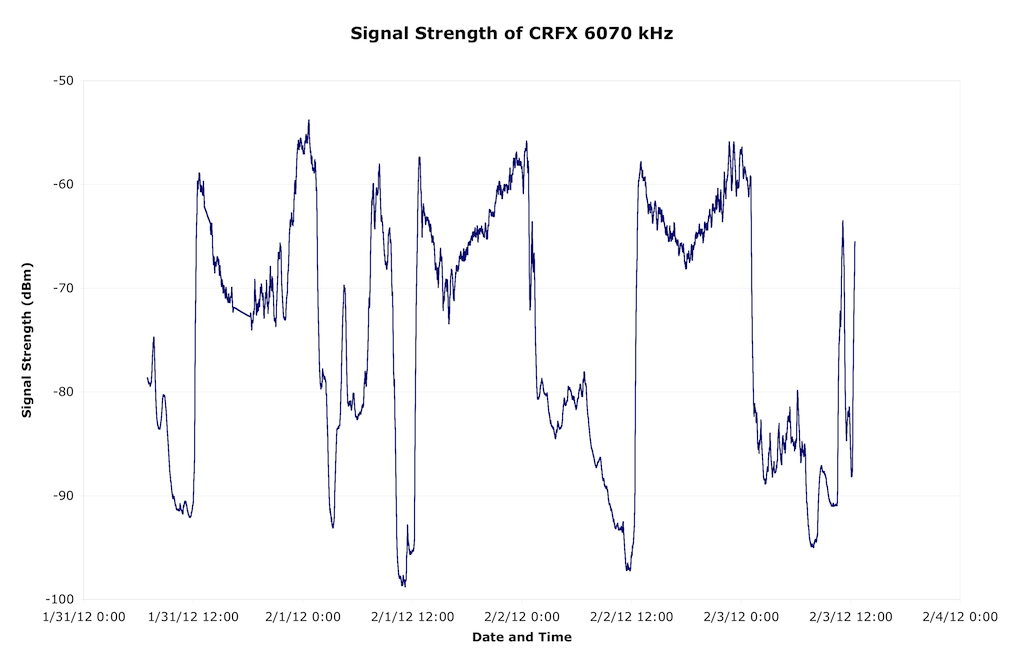My present workhorse antenna is a sky loop antenna with a 635 feet perimeter. What exactly is a sky loop antenna? The traditional definition from ham radio circles is that it is a full wave loop antenna, oriented in the horizontal plane. They are often used on 160 and 80 meters. The length or perimeter of a full wave loop antenna is 1005 feet divided by the frequency in MHz. So for 160 meters, say 1.9 MHz, it would be 1005 / 1.9 = 529 ft. The exact size of the loop may be important if you’re transmitting and want a reasonable SWR. For receiving only, it is not as critical, and the “bigger is better” rule usually applies. I ended up with 635 feet because that is the largest length I could easily install.
Here is a diagram showing the dimensions and orientation of the antenna:

Reversing the formula to 1005 / length gives you the resonant frequency, 1.58 MHz in my case, which is the top end of the MW band. From my experience, the antenna works great for the upper end of MW, especially the extended band (1610-1700), adequate for the middle of the MW band, and it produces very weak signals at the lower end of the MW band. I’ve yet to hear any transatlantic longwave stations with it.
The gain of a loop antenna is proportional to the area. While I don’t have enough space to substantially increase the perimeter of the antenna, I could add perhaps 200 feet at the most. An additional 200 feet would drop the resonant frequency to 1.2 MHz, but I’d substantially increase the area, so it may be a worthwhile project.
The height of the antenna varies dramatically, with some points barely 15 ft above the ground, others are around 40 ft. Again, this was what I could easily achieve. Raising sections of the antenna is a planned Spring project, it will be interesting to see what the improvement, if any, is.
The antenna is constructed from #16 insulated stranded wire, and is suspected from trees around the yard. The feedpoint is a 16:1 balun, and 100 feet of 75 ohm RG-6 coax runs from the balun to the shack. I’ve become a big fan of RG-6 coax for my antenna projects. This is the coax used for TV purposes. It’s available everywhere, and is incredibly cheap and low loss. Yes, it is 75 ohm, not 52 ohm, but for receive only antenna like this, who cares?
Running a NEC simulation, the free space resonant frequency is 1.59 MHz, with an input impedance of 140 ohms, which seems reasonable for a loop antenna. Over an average ground, this shifts to 1.55 MHz and 49 ohms, and over a good ground, 1.55 MHz and 27 ohms. Using an average ground, and running NEC simulations for other frequencies gives the following results:
MHz R X Z 1 35 -2421 2421 2 245 1735 1752 3 83 -181 199 4 941 -3196 3331 5 398 1082 1152 6 203 -354 408 7 2233 -1832 2888 8 507 768 920 9 346 -519 623 10 2392 -489 2441 11 542 437 696 12 447 -609 755 13 2113 845 2275 14 487 250 547 15 771 -650 1008 16 1564 786 1750 17 344 157 378 18 1029 -877 1352 19 1132 797 1384 20 470 47 472 21 1338 -998 1669 22 886 708 1134 23 410 -76 416 24 1497 -509 1581 25 748 664 1000 26 480 -173 510 27 1619 -194 1630 28 675 516 849 29 485 -239 540 30 1815 341 1846
R is the real component of the impedance, X is the reactive, and Z is the overall impedance, all values in ohms. As you can see, the impedance values are all over the place. Looking at them in closer detail would show even finer scale variations, but I’m not sure it would be too useful, as this is a simulation, an estimate of the antenna performance, these are not necessarily the impedance values of the actual antenna. Lies, damned lines, and antenna models.
The large Z impedance values over the HF range are why I went with a 16:1 balun, to better match them to the 75 ohm coax. The downside is that the loop impedance over MW is much lower, and the 16:1 balun probably produces a poor match. A 1:1 balun might be best for MW use, but I’m not sure what would happen at HF, I assume a poorer match and weaker signals. I spend most of my time on HF, anyway.
Below is a plot showing the gain of the antenna at three different elevation angles, 30 degrees (low angle radiation, ideal for DX), 60 degrees, and 90 degrees (which would be straight up) for a frequency of 6.9 MHz.

The red circle is the gain for 90 degrees, straight up. This angle for NVIS, where the radio waves are going virtually straight up from the transmitter, and being reflected straight down back to the Earth. The gain is 7.2 dB over an isotropic antenna (an antenna with no gain in any direction). For this case, the antenna has no favored direction, it is equally sensitive in all directions around the compass. For the lower angles, the antenna does have more gain in certain directions, and of course less in others. I find that for NVIS reception of pirates this antenna is excellent, so here’s one case of an antenna model actually approaching reality. DX reception is not bad either, I regularly pick up Europirates, and of course SWBC stations from all over.
One thing I like about the antenna is that it works reasonable well over all of HF and much of MW. I used to have dedicated dipoles for the various HF bands, but it was always a pain to switch antennas when tuning to a different band. And being a loop antenna, the noise levels are much lower than dipoles. I do wish the performance on the lower part of MW was better. I will try enlarging the antenna and see if that improves MW reception.
Don’t let the large size of my build of this antenna discourage you from building your own, if you don’t have the room for one of this size. A full wave loop antenna for 6.9 MHz is 146 feet – that’s a square 36 1/2 feet on a side. Such an antenna should work well from 43 meters on up.

